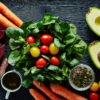”The vegan diet has become very popular. Check out this week's article to learn more about the vegan diet and how it can still support individuals who want to gain muscle mass.
Reading time: 10 Minutes
MWi Hacks:
- Learn about the differences between vegan proteins and proteins that come from animal products
- Discover what type of supplementation a vegan may consider when working out
Some fast facts:
- On Dec. 30, 2018 more than 14,000 people formally promised (by signing up through this website) to not eat animal products in January. Participation in Veganuary has more than doubled every year since the campaign began in 2014.
- Last year, restaurant consulting group Baum + Whitman identified plant-based food as a major trend for 2018. “That’s still true” for 2019, the copywriter(s) note [PDF], adding that this year lab-grown meats “look like profound long-range game changers.” (The brief writer also describes cows as “prolific poopers,” so BRB going to hire them to write for Popular Science.)
- In 2017, Nestle—whose brands range from Hot Pockets to Coffeemate to Haagen-Dazs to Digiorno—also identified plant-based foods a trend the company, in the words of its Executive Vice President of Strategic Business Units, “believe[s] is here to stay and amplify.”
- 6 percent of U.S. consumers now claim to be vegan, up from 1 percent in 2014. That’s a 500 percent increase, or a difference of 1.6 million people.
- Ariana Grande is vegan.
If you are one of the millions of folks who now call themselves vegan (or plant-based or whatever) and you have divulged this fact to anybody, you have probably been asked about your protein intake. People may have wondered about your muscle mass, or your strength. And it’s not a totally unreasonable concern. Generous protein intake is essential for maintaining and building muscle. Eggs, meat, and dairy make up roughly 62 percent of the protein consumed by U.S. adults—and that number may actually be greater when you consider that 8 percent of the protein consumed “could not be classified” (hot dogs??). The remaining 30 percent is plant protein, the largest dietary source of which is bread, which doesn’t exactly have a reputation for being protein-rich.
When I transitioned out of animal products a year ago—there are manyscience–backed reasons to reduce your animal product intake—the move seemed to run counter to my goals for athleticism and overall beefcakiness (pun intended). I’ve drained hours researching what humans need to build muscle optimally. When I tried to find research on how people who don’t eat egg whites, whey protein powder, or 93-percent-lean ground beef can optimize their gains, the Google Scholar well ran dry.
But even without recent or replicated peer-reviews papers, we have proof enough that getting buff with plants is, in fact, possible. There are enough vegan bodybuilders and Olympic athletes to show us it can be done. But how? I asked four experts and compiled their knowledge below.
If you aren’t vegan, Zinchenko says, you can get away with eating 2.1 grams of protein per kilogram of body weight, because the amino acid profiles in animal products are slightly better for making muscle. Pojednic notes that amino acid composition is “one of the key distinctions” between a vegan and an omnivorous diet.
Our panel: (1) Dr. Anastasia Zinchenko, a vegan bodybuilder, powerlifter, and coach with a PhD in biochemistry and books full of high-protein bake recipes. (2) Jordan David, a vegan bodybuilder, health coach, and founder of Conscious Muscle, which sells coaching, apparel, and supplements. (3) Dr. Rachele Pojednic, an assistant professor of nutrition at Simmons University. (4) Kendrick Farris, a vegan weightlifter who represented the U.S.A. in the 2008, 2012, and 2016 Olympic Games.
It’s worth noting that you don’t need to follow their guidelines to get adequate nutrition. These people are experts on gaining maximum strength and/or muscle mass, so they’re giving advice on getting jacked—not on simply being healthy. Humans actually do not need very much protein to stay well. But if you want to get buff with plants, read on.
As previously mentioned, the survival of our species does not require as much protein as many Westerners are led to believe. Adequacy, according to the United States’ recommended dietary allowance, is just 0.8 grams of protein per kilogram of body weight. So, for example, a person who weighs 170 pounds (or 77 kilograms) should eat about 62 grams of protein (that’s 77 x 0.8). Most people (especially meat eaters) get that without even really trying. A peanut butter sandwich on wheat bread, for example, has about 18 grams of protein.
But how much protein should people eat if they want to get ripped? “It depends on the training stage,” Zinchenko says. “Usually people who are new to lifting can build muscle faster than those who are already advanced. So a beginner lifter should eat more protein. But I usually recommend the same for all stages of training, because more protein doesn’t hurt anything.”
Zinchenko, who shares tips on her website Science Strength, recommends vegans eat 2.4 grams of protein per kilogram of body weight (or about 1.1 grams per pound). That’s a lot higher than what governmental organizations recommend, but her clients want to bulk up, not simply be healthy. And muscle gain requires the amino acids in protein. (More on that below.)
People who go to David for coaching are prescribed 1 gram of protein per pound of body weight, which shakes out to just a bit less protein than Zinchenko prescribes. Pojednic, a nutritionist, recommends training athletes get anywhere from 1.6 to 2.2 grams of protein per kilogram of body weight.
For context, a 170-pound individual would consume 185 grams of protein on Zinchenko’s plan, 170 grams of protein on David’s plan, and 123-169 grams of protein on Pojednic’s plan. That difference in protein consumption equates to roughly two protein shakes, or a block and a half of tofu.
If you aren’t vegan, Zinchenko says, you can get away with eating 2.1 grams of protein per kilogram of body weight, because the amino acid profiles in animal products are slightly better for making muscle. Pojednic notes that amino acid composition is “one of the key distinctions” between a vegan and an omnivorous diet.
Both Zinchenko and Pojednic call out amino acids leucine and lysine, in particular. Animal proteins generally have more of these amino acids than plant proteins (here’s a graph), which is significant because these building blocks seem to be particularly good drivers of muscle protein synthesis. You can boost your levels by incorporating a supplement, which Zinchenko recommends, though Pojednic notes that there are plenty of vegan sources of leucine: soy isolates (like soy protein powder), seaweed and spirulina, sesame seeds, sunflower seeds, and tofu.
“It’s not just about getting enough protein,” Zinchenko says, “The distribution of amino acid types is also important. It’s like building a house. It must have windows, bricks, and doors. You can have all the bricks in the world, but without a door, it’s not going to be a house.”
That doesn’t mean you need to make sure each serving of protein includes a mix of all the necessary amino acids, Pojednic says. If you’re eating a variety of foods throughout the day, there’s no need to pair up rice and beans for every meal. Your body can still put all the pieces together.
Even if your lunchtime salad has all the nutrients you want, your body may not be absorbing them. Some foods are harder for the human digestive system to turn into nutrients. Compared to meats, eggs, and dairy, vegetal proteins are not as bioavailable, meaning your body might not actually get to use all the protein contained in the raw spinach you scarfed.
Whole (also known as unprocessed) foods, which are recommended by the USDA, contain fiber and other substances that can limit absorption in the small intestine. “If you eat a raw vegan diet, you may need to aim for 2.7 grams per kilogram of body weight, which is just an insane amount of broccoli and beans,” Zinchenko says.
Whole foods generally take longer to digest, which is why serious muscle-builders may want to chug a protein shake on a relatively empty stomach—and why both David and Zinchenko recommend some sort of protein supplementation. Pojednic suggests it too, particularly if your stomach can’t handle a full meal after lifting.
Vegans need to take a B12 supplement. Most of the B12 humans get in their diet comes from animal products, as a result of microorganisms being processed in the guts of cattle and sheep. Without foods from those critters, it’s a lot harder to get adequate B12, which means vegans rely on fortified plant milks and cereals or supplementation. (Unless they are really into eating seaweeds like spirulina or dried nori, which contain B12.)
Otherwise, no, you don’t need to use a protein shake or branched chain amino acid powder—but they can make it a whole lot easier to get your protein in. Otherwise, 150 grams of protein a day (without just oodles of carbs) can be overwhelming.
David was a bodybuilder before he went vegan. In fact, he was “a total meathead.” His transition to vegan bodybuilding was simple: replace meat with meat substitutes. He is a “big proponent of tempeh” and usually advises his clients to eat two whole foods meals (like black beans and veggies or lentil soup), one meat substitute meal (like tacos with beefless ground), and one or two shakes.
Zinchenko encourages vegan lifters to “err on the side of caution” and eat about 50 percent of your protein from legumes (beans, peas, soy, etc.), 25 percent from grains, and 25 percent from nuts and seeds to make sure you’re getting adequate amounts of the necessary amino acids.
“The most recent recommendations clarify not just how many grams of protein you should eat, but also how those grams are pulsed throughout the day,” Pojednic says. “Scientists are thinking now that there’s only a certain amount of protein your muscles can uptake and utilize in one sitting. If you flood your system with amino acids, at some point they’re a little bit wasted.”
Aim to get 0.25 and 0.4 grams of protein per kilogram of body weight per meal. Or, to put it way simpler, space out your protein over 3 or 4 meals a day, not just all at once in a mega smoothie.
The other science-backed tip is to make sure you’re eating 20-30 grams of protein within 30 minutes (up to an hour is probably fine) of training. “The literature shows that ingesting both protein and carbs in that window promotes muscle growth and recovery, which helps you stay up on your training regimen.” Yes, that can be a protein shake—but it can also be a peanut butter sandwich.
The science is a little bit muddier for eating before and during training. Pojednic says to go with your preference, and how much food you want in your digestive tract while you’re doing heavy squats. Overloading your G.I. system is particularly easy for vegans, whose foods contain so much fiber. You can definitely get a tummy ache from eating a salad before training, because all the blood is “shunted away” from your digestive organs in favor of, say, your quads. If you don’t want to eat before training, but want to make sure you’ve got enough sugar in your system to get the most out of your workout, Pojednic recommends fruit juice.
MWi would like to thank Amy Schellenbaum for writing this article and supporting our community with her expert insights. Follow this link to read the original article:
https://www.popsci.com/vegan-diet-weightlifting-build-muscle-protein/
About the author:
Amy Schellenbaum oversees the 146-year-old Popular Science as it exists digitally. She has overhauled editorial strategy–slashing output from 25 stories a day to seven, in favor of more reporting and deeper analysis–as well as relaunched the site, established PopSci’s video program and forged alternative revenue streams. Year over year, she says, traffic from Google is up 100%.






